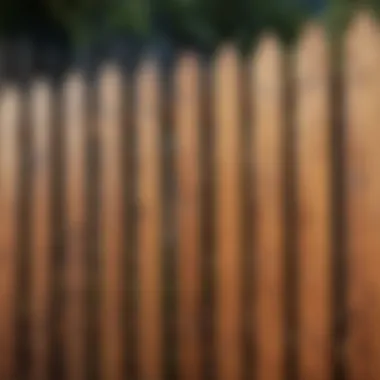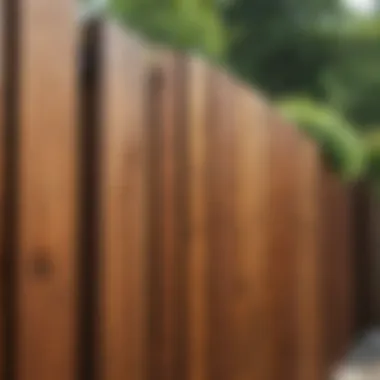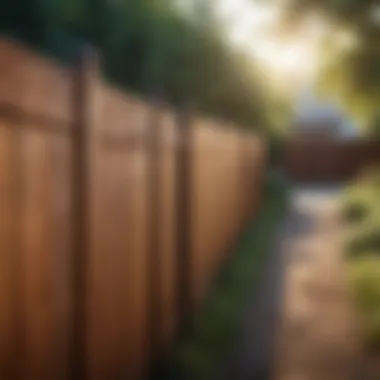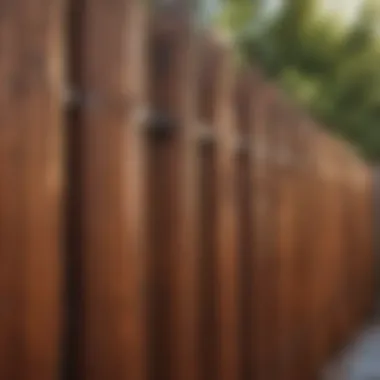Expert Guide to Staining an Already Stained Fence


Intro
Staining a previously stained fence can seem like a daunting task. The most important thing is to assess the condition of the wood. Look closely at the surface. Is the color faded? Are there any signs of peeling? Each of these factors influences how you will approach re-staining.
Knowing how to renew an already stained fence requires understanding the type of stain originally used. Not all stains are compatible with each other. This point cannot be overstated. Choosing the right stain can extend the life of your fence and enhance its beauty. The process involves several steps, starting from preparation up to application and maintenance.
In this guide, we will cover everything necessary for successfully staining a wooden fence. By the end, you should have a clearer roadmap for achieving a durable and visually appealing finish.
Design Inspiration
Design choices for your fence can significantly affect the overall aesthetic of your outdoor space. Analyzing current trends can provide fresh ideas for your project.
Trending Styles
Recent styles in fence staining focus on earthy tones and natural finishes. These colors allow the beauty of the wood grain to show through while providing protection. If you are looking for something more bold, dark hues such as ebony or deep mahogany can make a striking impact. Consider your home’s exterior and the surrounding landscape.
Color Palettes
When selecting a color palette, think about harmony with your greenery and architecture. Popular combinations include:
- Natural wood with a clear finish.
- Dark gray paired with white trim.
- Classic cedar with a soft beige.
Experimenting with these colors can help reflect your personal style while maintaining cohesiveness within your outdoor design.
Practical Tips
To guarantee the best outcome for your staining project, consider these practical tips.
Maintenance & Care
Proper maintenance of your stained fence will prolong its life. Regular cleaning is essential. A soft brush and mild soap can remove dirt and mildew buildup. It is also advisable to inspect for damage at least once a year.
Budgeting & Planning
Financially, it is wise to estimate your costs before starting. This should include:
- Materials: Stain, brushes, and protective gear.
- Tools: Sprayers, rollers, and ladders.
- Labor: Whether you plan to do it yourself or hire professionals.
Understanding these factors ahead of time can help avoid surprises down the road.
"Preparation and informed choices are the cornerstones of a successful staining project."
By following the guidance provided in this article, you will be well prepared to rejuvenate your stained fence effectively. Knowing how to choose the right materials and techniques will lead to a successful outcome.
Understanding the Need for Re-Staining
Re-staining a fence that has already been stained is more than merely a cosmetic update. It is essential for maintaining the wood’s integrity and prolonging its lifespan. Weather changes, UV exposure, and general wear can degrade the quality of the stain over time. For homeowners who prioritize their property's appearance and longevity, understanding when and why to re-stain is crucial.
Identifying Signs of Wear
Signs of wear are the first indicators that a fence needs attention. Recognizing these can save time and resources.
Fading Color
A faded color is a common sign. It often reflects the sun’s harsh effects. Wood naturally absorbs UV rays, causing colors to lose their vibrance. A bright, rich shade promotes visual appeal, making a home stand out. Yet, fading can signal the need for a fresh layer of stain to protect the wood underneath. This aspect is particularly critical in areas with ample sunlight. If neglected, the underlying wood may deteriorate, requiring costly repairs.
Peeling or Chipping


Peeling or chipping stains indicate poor adhesion or aging. If you observe patches of the old stain coming off, it is a red flag. This problem can develop from using the wrong type of stain or not preparing the surface adequately before the first application. It presents a practical concern; if left untreated, it can lead to further degradation. Re-staining here is beneficial, as it provides an opportunity to address the preparation issues from the past.
Rotting and Damage
Rotting or visible damage in your fence calls for immediate action. This is the most severe sign of wear. If sections of the wood begin to show softness or decay, the structural integrity is at risk. It affects not only aesthetics but also safety. Delaying repairs and re-staining can turn a manageable problem into a serious one. Thus, identifying rotting early contributes significantly to maintaining longevity.
Evaluating Surface Integrity
Surface integrity is vital to successful re-staining. Before applying a new stain, assessing the condition of the wood ensures that the new product will adhere properly.
Checking for Loose Boards
Loose boards can compromise the entire structure. This issue is common in older fences or those that have been under stress from extreme weather. It is essential to check for boards that may not be securely fastened. This inspection is beneficial because it allows for repairs before staining. Addressing loose boards supports the overall stability of the fence after re-staining.
Assessing Structural Stability
Lastly, assessing the overall structural stability cannot be overlooked. Look for any twisting or compromising that could affect the rest of the fence. Structural issues are often easier to fix when identified early. A stable fence provides a solid base for applying a stain, ensuring that the investment made in re-staining lasts longer. Maintaining stability is a wise approach to protecting your fence’s appearance and function.
Choosing the Right Stain
Choosing the right stain is a crucial part of refurbishing a stained fence. The stain affects the appearance, durability, and protection of the wood. A well-chosen stain enhances the fence’s aesthetic while ensuring it can withstand weather elements and time. Therefore, understanding the different types of stains available is essential, as well as knowing what factors will influence the choice.
Types of Stains Available
Transparent Stains
Transparent stains are a popular option when re-staining because they allow the natural beauty of the wood to show through. Their main feature is that they provide minimal coverage, highlighting the wood grains and maintaining the fence’s original character. This type of stain is ideal for those who appreciate the authentic look of wood. However, one downside is that they offer limited protection against UV rays, requiring reapplication more frequently. This is something to consider when deciding on a product, especially if maintenance is seen as a burden.
Semi-Transparent Stains
Semi-transparent stains balance qualities of both coverage and transparency. They enhance the grain of the wood but provide slightly more color compared to transparent stains. This type is a beneficial choice for those wanting to change the color of the fence while still showcasing the wood's grain. One unique feature is its ability to provide better UV protection than transparent stains, which can result in a longer lifespan for the finish. However, achieving uniformity in application can be a challenge, and uneven areas may not be as forgiving.
Solid Color Stains
Solid color stains offer the highest level of coverage and can completely change the look of the fence. This option is especially favorable for older wood that may have visible imperfections that one wants to hide. Solid stains provide an extended lifespan and superior protection against weather elements. Yet, the fence may appear less natural, and it can hide the wood grain, which may be a disadvantage for some who value the traditional appearance of wood.
Factors Influencing Stain Choice
Wood Type
The type of wood significantly influences the stain selection process. Different woods have various porosities and may absorb stains differently. For example, softwoods like pine often absorb stains more than hardwoods like oak. Selecting a stain compatible with the wood type will ensure better adherence and longevity of the finish. Moreover, knowing the wood type helps in choosing between transparent, semi-transparent, or solid stains, as some options may work better than others based on the wood's characteristics.
Desired Aesthetic
The aesthetic goal of the wood fence also plays a role in stain selection. For individuals wanting a specific color scheme or a certain ambiance in outdoor space, the right stain can create that desired visual appeal. Transparency levels and color options influence how the fence fits into the overall landscape. Yet, it’s crucial to be aware that the drying and curing process may subtly alter the final appearance, so testing the stain on smaller areas before completing the entire fence is a wise step.
Weather Resistance
Finally, understanding the weather resistance required for the fence is critical. Different stains offer varying degrees of protection against moisture, sunlight, and temperature fluctuations. If the fence is in a location that experiences harsh weather, opting for a stain with high durability becomes necessary. Some solid stains, for instance, may deliver better all-around protection than others, making it critical to weigh the options carefully based on local climate and exposure conditions.
Preparation for Re-Staining
Cleaning the Fence
Before applying any new stain, the fence needs thorough cleaning. If dirt and grime build up, it can prevent the new stain from adhering properly. This step is crucial for achieving optimal results and ensuring the longevity of your work.
Removing Dirt and Debris
The removal of dirt and debris is the first sub-step in the cleaning process. Accumulations of leaves, mud, and other organic materials can trap moisture against the wood. If not cleared away, this can lead to mold or mildew growth, compromising the integrity of the wood. For this article, the key characteristic of removing dirt and debris is its role in promoting effective stain adhesion. An advantage is that this step can often be performed with simple tools like a broom or a hose. However, this method may not address deeper grime that can accumulate over time.


Using a Pressure Washer
Utilizing a pressure washer can be an effective method in this process. This equipment can help remove not just surface dirt but also layers of old stain and mildew. A pressure washer operates by propelling water at high pressure, enabling efficient cleaning. The key benefit of this technique is its speed and thoroughness, making it a popular choice. However, one must be cautious. Too high of a pressure setting may damage the wood surface, causing splintering. Finding the right balance is crucial for maintaining the fence's integrity.
Chemical Cleaners
Chemical cleaners offer another avenue for ensuring a clean surface prior to re-staining. These cleaners can penetrate wood fibers to remove stubborn stains caused by mold or previous finishes. The important aspect of chemical cleaners is their ability to work where physical cleaning fails. Most often, these products can effectively restore the appearance of the wood. The unique feature is their variety, as some are specifically designed for wood surfaces. However, caution with these products is necessary, as improper use can lead to damage or discoloration. Furthermore, ventilation and protective gear are advisable when working with chemical solutions.
Sanding Existing Stain
After cleaning, sanding the existing stain is an invaluable step in preparation. This action smooths the wood and creates a uniform surface, which is ideal for application of the new stain. Proper sanding can assist in effectively removing the old stain, which can otherwise overpower the newer finish. Sanding also allows for better absorption of the new stain, ensuring an even appearance.
Hand Sanding Techniques
Hand sanding is a method that requires manual effort but provides great control over the sanding process. This method allows for attention to detail in corners and edges where machines might not fit. The distinctive aspect of hand sanding is its precision. It is especially beneficial for smaller areas or intricate designs. However, the disadvanatage is the time and effort it demands, which may be not ideal for larger surface areas, as it can be tedious and labor-intensive.
Sanding Tools and Equipment
For larger projects, sanding tools and equipment can make the process more efficient. A power sander can quickly cover large areas, saving time and effort compared to hand sanding. The utility of various sanders can be advantageous; an orbital sander may provide a smooth finish. Nonetheless, it's important to choose the right type of sandpaper as well, as this affects the final smoothness of the wood. One should be careful to avoid excessive sanding, as this could lead to thinning out the wood or damaging it.
Proper preparation directly influences the outcome of the staining process. Neglecting it will yield subpar results, leaving the wood vulnerable to damage and decay.
Tools and Materials Required
Essential Tools for Staining
Brushes and Rollers
Brushes and rollers are traditional tools for applying stain. They allow for precise control during the application, especially on detailed areas like edges and corners. A key characteristic of brushes is their versatility; they can reach into the grooves of the wood and thoroughly coat various textures. Rollers, on the other hand, are great for flat surfaces and can cover large areas quickly.
The unique feature of rollers is that they can facilitate an even application over expansive sections. However, they might not adequately cover intricate details as brushes do. When choosing between the two, consider the structure of your fence. Using both tools often yields the best results, maximizing efficiency while ensuring thorough coverage.
Sprayers
Using sprayers for stain application is becoming more and more popular. The main advantage of sprayers is their speed; they can cover larger areas in significantly less time compared to brushes and rollers. This means less strain on the user and more coverage in a shorter period.
Yet, there are disadvantages to consider. Sprayers may lead to an uneven application if not used carefully. The ability to control the spray pattern is paramount to avoid overspray onto unwanted surfaces. Sprayers require practice to master the technique, which can be a barrier for some homeowners.
Ladders and Drop Cloths
Ladders are often necessary for re-staining a fence, mainly when dealing with taller sections. The key function of ladders is accessibility. They allow you to reach areas that would be otherwise impossible when working from the ground. It’s essential to select a stable ladder to prevent accidents during application.
Drop cloths are equally important. They protect surrounding areas from drips and spills, preserving the landscape and saving the hassle of cleaning up afterward. The downside is needing to manage these materials during the work, which can sometimes slow down the process. However, their use greatly reduces the potential for damage, making the effort worthwhile.
Safety Equipment
Protective Gear
Safety is paramount when staining a fence. Wearing protective gear like gloves, goggles, and masks is essential. The primary role of protective gear is to shield you from harmful chemicals often found in wood stains and sealants.
A particular benefit of proper gear lies in its ability to prevent skin irritation and respiratory issues that can arise from exposure to fumes. Some stains contain volatile organic compounds (VOCs), which can be harmful in enclosed spaces without proper ventilation. While protective gear may feel cumbersome initially, it is a crucial element for a safe staining practice, ensuring that you minimize health risks while managing the project's demands.
Ventilation Considerations
Ventilation is another critical aspect of the re-staining process. Good ventilation ensures that any harmful fumes disperse quickly, protecting your health during application. Ventilation also aids the curing process. A well-ventilated area allows the stain to dry properly, ensuring a durable finish and preventing issues such as bubbling or premature peeling.
Using fans or opening windows can enhance air circulation dramatically, making a significant difference during the staining process. Without proper ventilation, the risk of health issues increases, making this consideration indispensable during your project.


In summary, the right tools and safety equipment significantly impact the success of re-staining an already stained fence. Prioritize investing in quality materials and protective gear to achieve the desired results and maintain a safe working environment.
Application Techniques
Application techniques are critical when it comes to staining a previously stained fence. The way you apply the stain can significantly affect the outcome, influencing both aesthetics and durability. It ensures that the stain adheres properly, leading to an even appearance and long-lasting protection against weather elements. Understanding these techniques allows homeowners to achieve optimal results, contributing to the overall lifespan of the stained surface.
Preparing the Stain
Mixing Stain Properly
Mixing stain properly is a foundational step in achieving a successful application. This process contributes to uniform color and consistency throughout the stain. Key characteristics of mixing include ensuring all components are blended thoroughly, which prevents variations in color and texture. It is essential to follow the manufacturer's instructions precisely, as each stain may have its own guidelines. One unique feature of mixing is the ability to customize the hue by combining different colors. However, mishandling the mixing process can lead to issues such as streaking and incomplete coverage, which can counteract the efforts put into re-staining the fence.
Testing Stain on a Small Area
Testing stain on a small area is a valuable practice before undertaking the entire project. This step allows you to see how the stain looks once applied to the surface and ensures that you are satisfied with the color and finish. The key characteristic of testing is that it helps identify any potential reactions with the existing stain or wood, preventing larger issues later on. This unique feature gives homeowners the opportunity to make adjustments before committing to the full application. However, it does require additional time and effort, which some may find to be an inconvenience.
Applying the Stain
Recommended Methods of Application
Recommended methods of application can vary depending on the type of stain used and personal preferences. Common methods include using brushes, rollers, or sprayers. Brushes allow for precision and thorough coverage, particularly in intricate areas. Rollers can speed up the process for larger areas, while sprayers provide the quickest application but may require more skill to achieve uniform results. This diversity in application methods gives homeowners flexibility, allowing them to choose what they find most effective. However, each method has its own set of challenges, like ensuring that overspray is minimized when spraying.
Uniformity and Coverage
Uniformity and coverage are paramount for achieving a professional look after staining. Ensuring uniformity means avoiding streaks and blotches, which can be distracting and visually unappealing. The key characteristic here is to apply the stain evenly, regardless of the method chosen, and to pay close attention to edges and joins. Achieving good coverage protects the wood and enhances its appearance, making it a critical aspect of the re-staining process. The unique feature of maintaining uniformity is that it improves the longevity of the finish, reducing the frequency of future maintenance. However, it may require additional time and careful attention to detail, particularly in a large area.
Post-Staining Care
Proper care following the staining of a fence is crucial for maximizing its longevity and visual appeal. This phase involves two main components: curing time and maintenance recommendations. Curing ensures that the stain fully adheres to the wood, while maintenance keeps the fence looking fresh and extends its life. Paying attention to these details will help avoid premature wear and tear, ultimately providing better protection for your wood.
Curing Time
Curing time refers to the period required for the stain to fully set and bond with the wood surface. This process is influenced by several factors that can significantly impact the outcome of your staining project.
Factors Influencing Curing
The curing time can be affected by conditions such as temperature, humidity, and the type of stain used. Generally, warmer temperatures and lower humidity levels facilitate faster curing. Different stains also have unique drying times. For example, oil-based stains tend to require longer curing periods compared to water-based stains. Understanding these characteristics is essential. It allows homeowners to choose the best conditions for application, leading to a more durable finish.
A key characteristic of curing is its direct impact on stain penetration. When the conditions are optimal, the stain binds effectively, offering a longer-lasting barrier against environmental elements. This benefit is particularly significant in climates that experience heavy rainfall or intense sunlight, as the wood will be better protected.
Signs of Proper Curing
Recognizing the signs of proper curing is vital to ensure that the staining process has been successful. Some indications include a uniform color throughout the surface and a lack of tackiness. Tackiness can suggest that the stain has not cured properly and may require additional time or intervention.
A unique feature of properly cured stain is its ability to resist peeling and flaking. Once cured, a well-stained fence maintains its visual appeal for a longer duration. This advantage is critical for homeowners who seek to minimize the frequency of re-staining, thus saving time and resources.
Maintenance Recommendations
Once curing is complete, ongoing maintenance plays an essential role in preserving the integrity of the stained fence. Maintenance not only enhances appearance but also extends the life of the wood.
Regular Cleaning Interval
Establishing a regular cleaning interval is important for caring for a stained fence. Dirty surfaces quickly become unsightly and can encourage rot and decay. Therefore, it is advisable to clean the fence at least once a year or more often if located in a dusty or polluted area.
Maintaining this interval can also prevent the buildup of moss or mildew, which can deteriorate the wood over time. A simple wash with mild soap and water typically suffices, but homeowners should adapt their cleaning strategies based on environmental factors.
Inspecting for Damage
Regular inspection for damage is indispensable for the longevity of the fence. This step allows homeowners to identify issues such as cracks, splitting wood, or areas where the stain may have worn away. Early detection of these problems can prevent more extensive repairs or complete re-staining down the line.
A primary benefit of routinely checking for damage is that it empowers homeowners to act proactively rather than reactively. For instance, fixing small cracks before they grow can save significant time and expense. Furthermore, this diligence contributes to the overall aesthetic of the property, helping to maintain its value.
"Good maintenance goes beyond mere aesthetics; it preserves the integrity of the wood against the test of time."
Overall, the post-staining care for a fence encompasses both curing time and ongoing maintenance strategies. By understanding and implementing these practices, homeowners can ensure their fences remain appealing and functional for many years.















